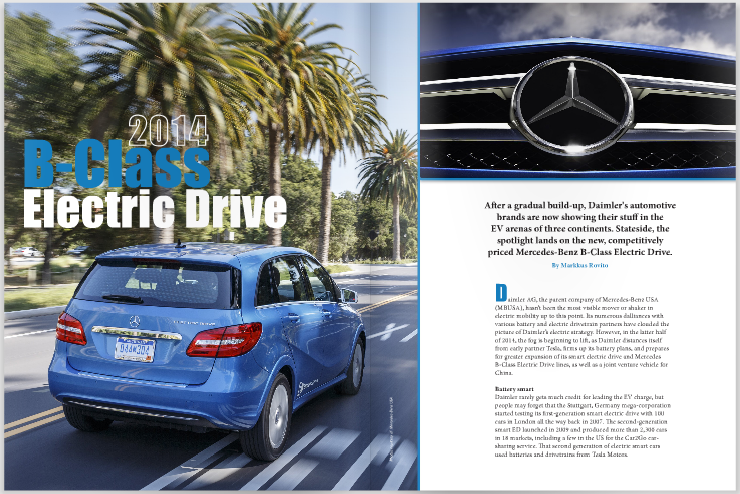After a gradual build-up, Daimler’s automotive brands are now showing their stuff in the EV arenas of three continents. Stateside, the spotlight lands on the new, competitively priced Mercedes-Benz B-Class Electric Drive.
Daimler AG, the parent company of Mercedes-Benz USA (MBUSA), hasn’t been the most visible mover or shaker in electric mobility up to this point. Its numerous dalliances with various battery and electric drivetrain partners have clouded the picture of Daimler’s electric strategy. However, in the latter half of 2014, the fog is beginning to lift, as Daimler distances itself from early partner Tesla, firms up its battery plans, and prepares for greater expansion of its smart electric drive and Mercedes B-Class Electric Drive lines, as well as a joint venture vehicle for China.
Battery smart
Daimler rarely gets much credit for leading the EV charge, but people may forget that the Stuttgart, Germany mega-corporation started testing its first-generation smart electric drive with 100 cars in London all the way back in 2007. The second-generation smart ED launched in 2009 and produced more than 2,300 cars in 18 markets, including a few in the US for the Car2Go car-sharing service. That second generation of electric smart cars used batteries and drivetrains from Tesla Motors.
While Tesla was introducing its EVs to the market from the top down, starting with the six-figure Roadster sports car, Daimler took the opposite tack, trickling EVs onto the roads via the diminutive smart car, a vehicle that probably bugged Europeans less than Americans, many of whom saw it as just the kind of stereotypical glorified golf cart that EV protagonists would rather banish from public perception. However, the smart fortwo had already existed since 1998 as an ICE car and sold well internationally, so Daimler had a bankable brand with which it could introduce EVs to its customers.


“From the very beginning when Daimler worked with the Swatch founder on the smart, we were always thinking about it being an urban car, and thought of it from the very beginning as an electric car,” said Mark Webster, General Manager of both smart and E-mobility for Mercedes-Benz USA.
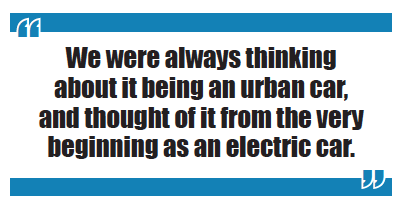

Perhaps too, the company had always thought of Tesla as a temporary partner, although it acquired a small equity stake in the start-up in 2009. By the time the third-generation smart ED rolled around at the September 2011 Frankfurt Motor Show, it had a new, range-increasing battery pack and new drivetrain, both produced by Deutsche ACCUmotive. Daimler had been working with Deutsche ACCUmotive initially as a partnership, and then in April of this year, Daimler bought that company, as well as Li-Tec Battery, another German battery firm. Those two companies gave Daimler ownership of both the smart fortwo’s battery cells and complex battery electronics. That same month, Daimler CEO Dieter Zetsche confirmed that his company would not invest in the Tesla Gigafactory.
At that point, it seemed pretty clear that Daimler aimed to produce its own batteries for smart and Mercedes EVs. However, in May, the German Manager Magazin reported that Daimler planned to close Li-Tec no later than 2016, citing the company’s failure to meet the capacity required to produce 30,000 cars per year. Now the apparent goal is to keep Deutsche ACCUmotive and move Li-Tec’s work over to LG Electronics in Korea.
So while Daimler’s battery supply chain remains in flux, the company’s concern over meeting battery capacity aligns with what Webster told us, that “we continue to be committed to smart and electric vehicles.”
And sales continue to mount. From May 2013 to July 2014, the third-gen Smart ED sold 2,311 units in the US and more than 6,500 worldwide. Its US sales make it the third best-selling pure EV in the country behind the Nissan LEAF and Tesla Model S, although the recently released BMW i3 is now outpacing the Smart ED’s monthly sales. We already know that a fourth-generation smart ED is in the works, to be revealed as early as August 2015, according to Webster. It’s not determined whether the fourth-gen will be a 2016 or 2017 model. “That still remains to be seen,” Webster said, “but we’re definitely going to come out with a fourth-generation EV model.”


Electric Benz
While the new BMW i3 has so far beaten the smart ED in monthly sales, a closer electric competitor to the $42,275 i3 is Daimler’s other EV, the new Mercedes B-Class Electric Drive, which launched on July 15 for a starting price of $41,450 (as low as $33,950 depending on available incentives).
Sales figures will need at least a few months to see if a trend develops, but suffice it to say, the B-Class ED is the model that some drivers have been specifically waiting for: the first Mercedes-Benz EV. Shortly after its release, Green Car Reports wrote a piece on its first American buyer, a long-time Mercedes driver who wanted an EV, but didn’t want to spend the money on a Model S or settle for the smaller, less-featured LEAF or Volt.
That customer seemed uncannily in line with the type of person Webster told us would want the B-Class EV. MBUSA is using taglines to sell the car such as “Zero Emissions, Zero Compromises;” “Equipped, Not Stripped;” and the deadpan, meta “the Mercedes-Benz of electric vehicles.” The point of them all is that the B-Class delivers the same kind of Mercedes experience as its other models, with many luxury features included in the base model.
“We’re not asking you to change your lifestyle,” Webster said. “People who are familiar with our cars will find all the normal amenities associated with Mercedes-Benz: safety, comfort, luxury and performance. Plus the benefits of electric vehicles: instant-on power, the savings, and all those things. So I think both within our Mercedes family and outside of the Mercedes family, we have a place. It’s not for everybody, but we think we have a very versatile, great car. It’s good from the suburbs to the city and back.”
Of course, there are a couple of general and EV-specific omissions from the B-Class. The aforementioned first buyer, Kim Price, said she wanted a sunroof option and Apple Carplay, the latest iPhone-to-car sync technology that 2015 Mercedes C-Class cars will adopt.
Beyond that, Daimler has chosen not to include DC fast charging in either the B-Class ED or smart ED. It’s an odd omission for the pure EVs, and although we have probed a few Mercedes representatives on the topic, we’ve have yet to hear a clear rationale for the decision. Webster did note that “from some studies that survey people across all OEMs…a very small percentage of them use DC charging, and as you know, they’re very expensive.” However, we were also told at a B-Class launch event that the next-generation vehicle would include DC fast charging, and Webster echoed that statement, saying, “I would expect that down the road, our other vehicles will offer DC charging.”
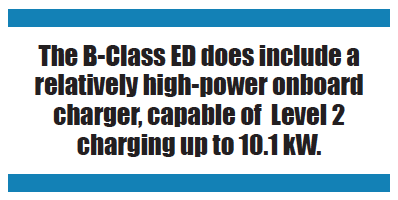

For now, the B-Class ED does include a relatively high-power onboard charger, capable of Level 2 charging up to 10.1 kW. “We’re strongly encouraging our dealers and customers to buy the Level 2 charger, because with a 110-volt, it takes a while. We want them to charge it quickly.”
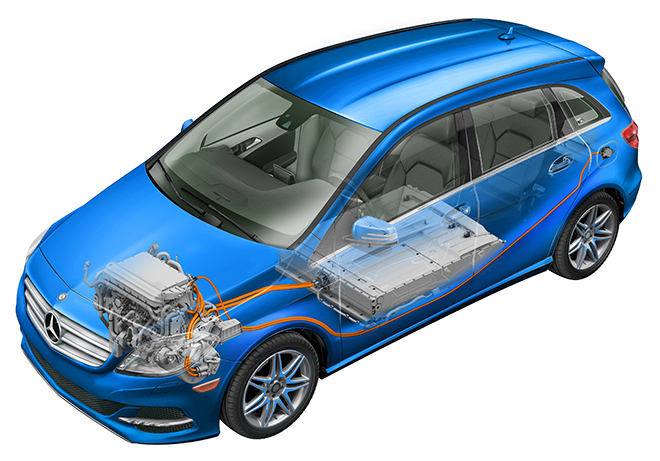

With a Level 2 charger drivers can fully recharge in as little as 3.5 hours. “For 60 miles of range, that charge would take just two hours,” said Webster.
It’s also interesting to note that the B-Class sources its battery, motor, transmission and power electronics from Tesla, so even if the Daimler-Tesla connection may be fading, the first Mercedes-Benz EV will prove its worth on the back of some important Tesla tech.
Some of the B-Class ED’s most intriguing features are available as options. For example, there’s a $600 option that’s unusual in EVs called Range Plus. Webster was quick to point out that it’s not to be confused with a range extender. “There are different terms for different things,” Webster said. “We call it the Range Plus. It’s not really a range extender – that could be confused with other manufacturer’s offerings. Ours is a Range Plus, which allows you to supercharge the battery. You push the button the night before when you’re charging it, and then it gives you more capacity. It’s for occasional use, and it’s been well received by our dealers and customers. It gives you about an extra 15 miles. The EPA range is 87, so it will bring that up to about 102 miles. It all depends on the driving situation, temperature, etc.”
Webster also noted in an interview with Cnet that using the Range Plus too often “could impact the life of the battery.”


Another very cool option provides a unique radar-based regenerative braking system with four energy recuperation levels, from gliding to maximum recuperation. The system uses a radar sensor to watch the traffic ahead and then optimize braking for maximum energy regeneration. It also includes steering wheel-mounted paddle switches for manually toggling among the four regeneration levels.
Riding the B
The B-Class ED model that I was able to test-drive in Palo Alto, California had the radar regenerative braking system installed, and it was one of the highlights of the ride. The recuperation-level paddles are located conveniently and comfortably by the hands in steering position, and you immediately notice the difference when changing levels. The lowest, “gliding” level feels the same or close to driving with no regenerative braking at all, and the levels increase gradually until the highest level, at which, when you take your foot off the accelerator, the regenerative braking kicks in hard, to the point where you just barely need to use the brake pedal to come to a complete halt.
As an efficiency nut, I liked the B-Class ED’s highest level of regenerative braking the best, not only because it improves your mileage, but also because I could use the brakes much less frequently. Particularly, while driving up the kind of iconic, two-lane, twisty road that you find so often in Northern California’s forested areas, rather than frequently applying the brake to take the many sharp turns slower, the automatic regenerative braking provided all the slowing down necessary, so I could comfortably navigate the winding roads with the accelerator pedal only. Not only was it a fun, smooth ride, but that kind of terrain proved to be easy on the remaining range from the battery. Coming down from a hilltop winery back to downtown Palo Alto, the available range started at 27 miles, and after a 15.5-mile drive, the available range sat at 24 miles. Obviously, you’re not going to be driving downhill on snaking roads everywhere you go, but that was an excellent way to showcase the regenerative potential of the B-Class ED.
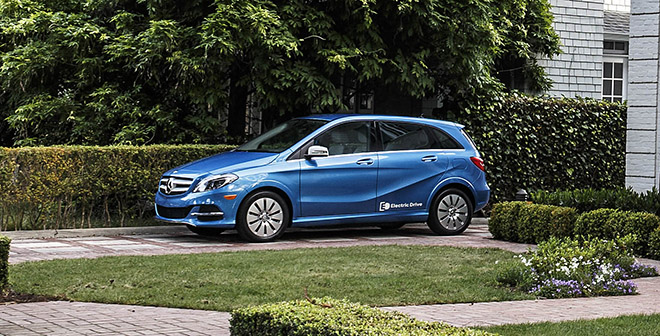

Overall, the B-Class ED felt like a very solid contender for a four-door EV. It’s more spacious on the inside than it seems, including the fairly roomy trunk. Its navigation system worked well and showed nearby amenities, such as charging stations, as icons onscreen. Like many EVs, it comes charging out of the gate with impressive torque, and its Mercedes-level interior features focus on comfort.
Because EV designs and stylings are fun topics for debating whether something looks “too electric” or not, it’s interesting that the B-Class doesn’t really have the same level of sleek, elegant looks that we’re used to in a Mercedes-Benz. Neither does it look too obviously electric. The reason for both is that the B-Class is not an original design made just for launching Mercedes-Benz’s first EV.


The platform has existed for years as a more practical Mercedes in Europe and Canada, but it’s not very familiar to Americans, because it’s only shown up in tiny numbers in California for the company’s fuel-cell program. But the versatile B-Class can accommodate many types of drive systems.
“The car has always been designed to handle different types of propulsion systems or types of fuel,” Webster said. “The B-Class specifically has the energy floor for either fuel cell, electric vehicle in this case, or diesel and gasoline. So when we launched it here, we wanted to use it as our electric vehicle platform.”
The B-Class ED launched initially in the 10 American ZEV (zero emission vehicle) states, and in late 2014 or early 2015, Mercedes-Benz will expand that to all 50 states. Webster hinted at some international expansion for the B-Class ED, but did not have any specific details to confer when we spoke. The same was the case for a fuel-cell B-Class – Webster said there would be a production fuel-cell car beyond the 100 from the California pilot program, but he could not say when that would happen.
Other horizons: SLS AMG, S-500 and Denza
While the smart and B-Class electrics are on Daimler’s front burners for electric drive, the company has other irons in the fire, as well. As an extreme counterbalance to the smart ED micro-car, the Mercedes-AMG high-performance brand put out the drool-worthy yet near-unattainable SLS AMG Electric Drive supercar last year. With the potential of electrification on its side, the SLS is the most powerful AMG car ever made at 740 hp and 738 lb-ft of torque. It has 120 miles of electric range, and starts at $544,000, making it a prestige vehicle to say the least.
Another high-end plug-in from Mercedes-Benz, the S-500 Plug-in Hybrid, just started shipping in September to European dealerships. It has some impressive features to match its mighty price tag of €108,944 ($143,000). It combines a V6 3.0-liter twin turbo engine with a 436 hp electric motor for some peppy acceleration and almost 21 miles of all-electric range. Meanwhile, its standard Comand navigation system optimizes electric motor use based on the current destination. However, there’s no word on whether this pricey plug-in will make its way out of Europe.
On the more practical end of EV expansion, Daimler has revealed its joint-venture vehicle with Chinese company BYD: the four-door battery EV sedan called Denza. The two companies have a facility in Shenzhen for producing the car, which will not reach American shores, but roughly translates to a $60,000 sticker price.
The Daimler/BYD joint venture seems to lean on Daimler’s engineering prowess in order to meet or exceed the new Chinese crash-safety regulations and other quality standards, while taking advantage of BYD’s expertise in battery technology.
Daimler CEO Zetsche has called BYD “one of the most advanced makers of batteries for electric vehicles,” and the Denza delivers a massive 47.5 kWh Li-ion battery with a range of around 186 miles. Spokespeople noted that the Denza is good for a few days of the average Chinese commute of 30-50 miles on a single full charge.
The BYD relationship begs another question about Daimler’s overall battery strategy. Will they utilize BYD for EV batteries beyond Asia? Or will Daimler simply employ several battery suppliers, including one of its own companies? In the face of those questions, one thing seems certain: that Daimler is expanding the foundation of its EV business, which would back up what Webster said about Daimler’s electric vehicle goals.
“We’re definitely committed to the electric segment and plug-in hybrids,” Webster said. “We’re working on other electric vehicle offerings right now, even though we just came out with the B-Class. Hopefully the tide for all EVs will rise, so we get more entrants into the market.”
This article originally appeared in Charged Issue 15 – August/September 2014




